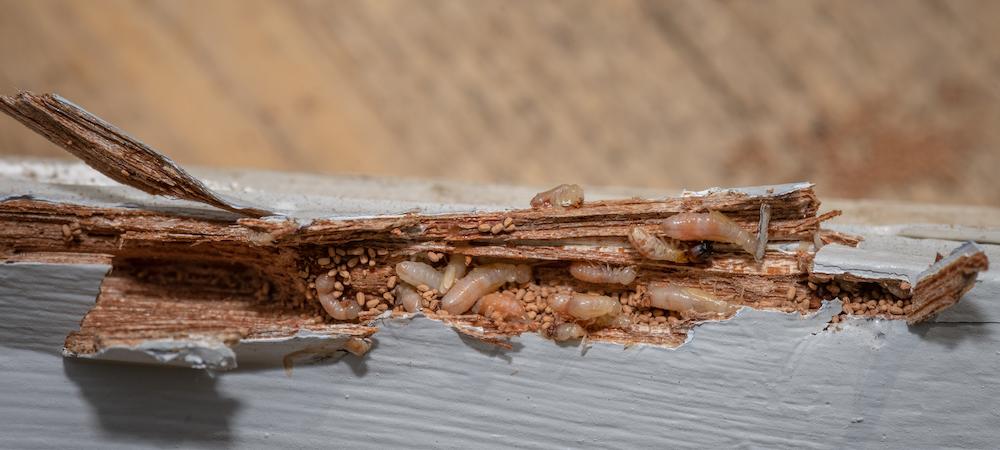They say Virginia is for lovers, but termites? We’re not so in love.
These sneaky, silent destroyers have no business coming over uninvited, and yet, they frequently do, and with disastrous results. Termites can cause severe damage throughout the Mid-Atlantic region, from rural woodlands to bustling urban areas.
But you don’t have to face these pests alone! In this blog, we’re here to help you protect your Virginia home from these pesky pests.
From spotting early warning signs to implementing preventive measures, we’ve got all the information you need to keep your home termite-free for the long term.
Understanding the Different Types of Termites in Virginia
Termites are a common problem in Virginia, with two main species threatening the region’s homes: the Eastern subterranean termites (Reticulitermes flavipes) and the highly destructive Formosan subterranean termites (Coptotermes formosanus).
While each species behaves differently, they can both cause serious damage to your home and other wooden structures.
These pests are equal-opportunity invaders, targeting everything from rural cabins to modern city homes. Their shared trait? A relentless hunger for cellulose, found in wood and plant materials.
Formosan termites, for example, are infamous for building super colonies that can consume over a pound of wood daily! That’s like having a wood chipper under your roof.
Eastern subterranean termites move slower, but make up for it with their persistence. Either way, without intervention, either of these pests can chew through your home’s structural integrity faster than you’d believe.
Overview of Termite Biology, Behavior, and Colony Structure
As social insects, termite colonies are organized into castes comprising workers, soldiers, and reproductive individuals like the queen and king.
Depending on the species, the colonies can live underground with intricate tunnels connecting them to your home, while others will establish their homes directly in dry or wet wooden structures.
What’s their main goal? Cellulose.
Aided by symbiotic bacteria in their digestive system, termites regularly chew through wood and the occasional plant materials to meet their nutritional needs. This continuous search for food can pose a persistent threat, potentially causing extensive damage if not addressed promptly.
What Are the Most Common Signs of Termites in Virginia?
Think you’re safe because you’ve got a pristine-looking home? Think again. Termites are experts at hiding in plain sight, and they don’t care if your home is sparkling clean or a total pigsty.
Instead, here are four other signs that might mean it’s time to sound the termite alarm:
- Mud Tubes: These pencil-thin “highways” show up along your foundation, walls, or other surfaces. They allow subterranean termites safe passage to and from their food source.
- Swarming Alates: Winged termites show up during breeding season, looking for new places to create colonies. See them flying around your property? Trouble’s brewing.
- Wood Damage: Tap on your wooden structures—if it sounds hollow or you notice sagging wood, termites may already be hard at work.
- Discarded Wings: Spot piles of what look like tiny fish scales near windows or door frames? That’s a sure sign of termites departing for their next big adventure.
If you’re looking for frass—the sawdust-like droppings some termites leave behind—don’t hold your breath. Virginia’s most common termites, including subterranean species, recycle theirs into mud tubes. You won’t likely see frass with these termites. Although it’s certainly possible that it might pop up here and there, it won’t serve as the ultimate verification that you’re dealing with these types of pests.
Why Termites in Virginia Spell Disaster
Virginia’s humid summers and mild winters create the perfect conditions for termites to thrive. Combine that with the moisture-retaining soil and wooded areas common in many neighborhoods, and you’ve got a termite hotbed.
Unfortunately, this means every home in our state is at risk, especially properties that are surrounded by dense vegetation or prone to drainage issues.
But don’t panic! Knowing you’re at risk is half the battle. The other half? Taking a few proactive steps to protect your home, which we’ll cover next.
Protecting Your Home From Termites in Virginia
Defending your home from termites requires more than waving a can of bug spray around. If you want to protect your biggest investment, you’ve got to fight smart. Here’s how:
Landscaping and Vegetation Management
Your lawn could be unintentionally rolling out the welcome mat for termites, but a well-maintained lawn can help deter termites and other pests. Start by clearing the area around your home by removing excess vegetation, mulch, and wood debris; these materials can attract termites to inch closer near and into your home.
When landscaping, opt for plants that termites are less attracted to, and avoid planting anything too close to your home’s foundation. Regularly trim trees and shrubs that may touch your house, as they can provide easy access for pests to reach your home.
Seal the Cracks and Fix the Leaks
Termites love moisture as much as they love wood. Don’t give them easy access. Seal every crack, crevice, or tiny gap in your foundation and walls. And while you’re at it, fix that dripping faucet or leaky gutter—they could be turning your home into termite paradise.
When you’re building or renovating, consider using termite-resistant materials like treated wood or even concrete. Better to plan ahead than pay a hefty repair bill later.
As we mentioned, don’t forget about the water issue. Use dehumidifiers in problem areas like crawl spaces and basements.
Pay close attention to proper drainage around your property—standing water is a big thumbs-up for these pests as it is for countless others, like mosquitoes. Avoid overwatering your plants, and make sure your downspouts are directing water far away from your home.
Termite Barriers and Physical Deterrents
Want the ultimate defense? Physical termite barriers, such as metal mesh or termite shields, are excellent deterrents. While these measures may require professional installation, the added protection is well worth it in high-risk areas.
The Best Offense Against Termites? Early Detection
Don’t wait until your floors are sagging to take action. Schedule yearly professional termite inspections to stay ahead of any potential infestations. The pros have the tools and expertise to spot the signs you might miss.
Want to DIY in between inspections? You can keep an eye out for mud tubes and hollow-sounding wood yourself, but remember—professional inspections remain your best bet for catching those sneaky invaders.
Call the Experts at Connor’s Pest Pros
Termites may be persistent, but they’ve got nothing on us at Connor’s Pest Pros. With decades of experience protecting Virginia homes, we know what it takes to stop termites in their tracks.
Whether you suspect termite activity or buying or selling a home, our pest professionals have the expertise, tools, and treatments to detect and address termite infestations, protecting your home from costly damage.
Contact us today to set up a treatment service or schedule a time for one of our technicians to complete a Wood Destroying Insect Report (WDIR) before your home sale.
With Connor’s Pest Pros by your side, you’re not just fighting another battle against termites—you’re winning the entire war.



